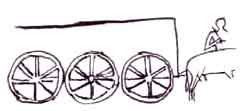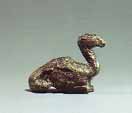Daily LifeTransportationTransportation across the Nile was only possible through the areas between the six cataracts. The flow of the river in cataract zones is interrupted by rocky heights. Rock drawings at Sabu (Sudan) depict groups of rowing boats being steered with, as many as 22 oars.1 These drawing have been dated to, approximately, the 3rd-2nd millennia BC period. Also, in Kerma, are several wall paintings of boats associated with fishing activities.2 One of these paintings depicts twelve men aboard a boat. One of the men holds a net waiting for a catch. Below the boat are twelve fishes and two crocodiles. These drawings and paintings make it certain that the inhabitants regularly used boats for fishing and, obviously, transportation.
Donkeys are the oldest means of transportation known in Sudan. The use of donkeys continued in Sudan even after the domestication of horses. They were used for short distant travel, such as for pulling coffins. A relief from the temple of Amon at Sanam, depicts donkeys, or perhaps mules, pulling three to six wheel vehicles.3 An Egyptian wall painting from the tomb of Tutankhamun at Thebes depicts a Kushite princess and her servants facing Tutankhamun and aboard an oxen-chariot. On the coffin of Sebni, an Egyptian administrator who lived during the reign of Egypt’s Sixth Dynasty, is an inscription about a Kuhsite "caravan."4 Thus, both oxen and donkey-caravans were used for long-distance transportation since the very early days of the Kushite civilization.
Historians commonly agree that horses were introduced to Kush sometime during the Hyksos rule of Egypt (1720-1550 BC).5 However, an inscription from the Egyptian temple of Hatchepsut at Dier El Bahr, dating to the fifteenth century BC, mentions something about a horse that had been brought to Egypt from the land of the Punt,6 i.e. the region encompassing Eastern Sudan and Eriteria. This inscription has undermined what historicans previously thought; the presence of horses in Africa may predate the Hyksos' invasion of Egypt: "These, as they wend their way towards the ships, are accompanied by natives of Punt, some carrying large logs of ebony, others leading apes, and one a giraffe. In one place where there is a great gap in the wall, the remains of the inscription show that an elephant and a horse were among the animals embarked from Punt for the gratification of Hatasu."7 Starting from the sixth century, Kushite pharaohs started to extensively domesticate horses. Horses may have been considered sacred since the Kushite pharaohs of the Napatan period were often found buried together with their horses. However, unlike the Egyptians, the Kushites preferred to ride directly on top of horses rather than to use chariots or oxen.
The Kushite pharaoh Piankhy was noted for his love of horses.8 On his stele at Jebel Barkal, it is written that after he has conquered the city of Hermopolis, he headed to the royal stables to check the condition of horses.9 Piankhy was enraged when he saw the terrible situation under which the Egyptians have kept their horses. In the fifth century BC, the Persians brought the camel to Sudan. Unlike horses, camels are noted for their ability to endure the harsh desert environments and they are also capable of carrying heavy imports for long distance travels. However, the Kushites did not tame the camels as much as the Nobatians, i.e. the desert Nomads who occupied North Sudan starting from around the third century CE.10 At their royal graves, the Nobatians extensively slaughtered and buried camels along with their owners.11
Edited: Jan. 2009. |



